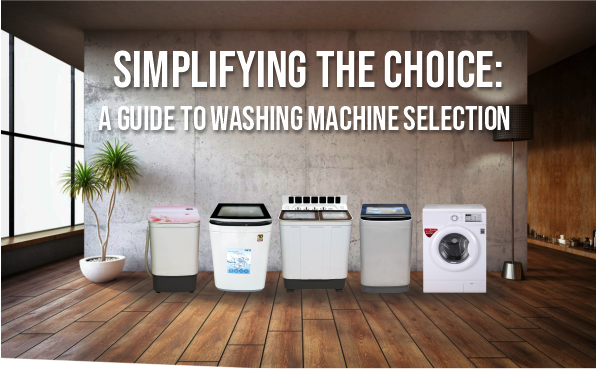
Introduction: Washing Machines: Your Everyday Laundry Companion
Choosing the right washing machine in today's fast-paced world can significantly impact our daily lives. With numerous options flooding the market, understanding the distinctions between semi-automatic and fully automatic washing machines is crucial. This comprehensive guide aims to provide essential information to make an informed decision based on preferences, budget, and household needs.
Understanding the Differences: Semi-Automatic vs. Fully Automatic Models
Hands-On vs. Hands-Free: Unveiling the Contrasts
The choice between semi-automatic and fully automatic models dictates your level of involvement in the washing process. Semi-automatic machines require manual intervention, while fully automatic machines offer a hands-free experience.
Budget Matters: Weighing the Cost Factors
Despite higher upfront costs, fully automatic machines often result in lower maintenance and utility expenses over time, making them a cost-effective choice.
Convenience Galore: Exploring the Versatility Quotient
Semi-automatic machines offer more control, while fully automatic machines provide a set-and-forget convenience, ideal for busy households.
Water and Energy Efficiency
The Water-Wise Champion: A Look at Fully Automatic Machines
Fully automatic machines regulate water usage, leading to reduced water consumption compared to their semi-automatic counterparts.
Managing Utility Bills: Assessing the Energy Consumption
Fully automatic machines come with energy-saving features, making them a more sustainable and cost-effective choice in the long run.
Sustainability Wins: Embracing Environmentally Friendly Options
Opting for a fully automatic machine not only saves water and energy but also contributes to reducing your overall environmental impact.
Cost-Effectiveness
Initial Investment vs. Long-Term Savings: A Cost Breakdown
Fully automatic machines prove to be more cost-effective over time, offsetting their higher upfront costs with lower maintenance and utility expenses.
The Durable Choice: Understanding Maintenance Costs
Investing in a fully automatic machine ensures lower maintenance and utility expenses, making them a durable and cost-effective choice.
Making Every Penny Count: Evaluating the Overall Value Proposition
Fully automatic machines provide a seamless and efficient laundry experience, justifying the initial investment and offering long-term value.
Versatility and Convenience
Control at Your Fingertips: The Semi-Automatic Advantage
Semi-automatic machines offer customizable settings, providing users with a hands-on laundry experience.
The Luxury of Time: Embracing Fully Automatic Ease
Fully automatic machines offer set-and-forget convenience, freeing up time for other tasks.
Tailored Solutions: Customizing Wash Programs for Varied Needs
Both semi-automatic and fully automatic machines provide customized wash programs, ensuring the longevity and quality of your clothes.
Key Features to Look for in Your Washing Machine
Assessing the size, load capacity, wash programs, energy efficiency, noise levels, and ease of maintenance ensures a well-rounded decision.
Efficient and Effective: Maximizing Load Capacity for Time Savings
Adjustable load settings allow for washing smaller loads without compromising efficiency, providing time-saving benefits for busy households.
Smart and Sustainable: Investing in Energy Star Rated Machines
Choosing Energy Star rated machines guarantees adherence to energy-saving standards, ensuring efficient and sustainable laundry practices.
Peaceful Operations: Reducing Noise for a Tranquil Home Environment
Opting for washing machines that operate quietly minimizes disturbances, ensuring a peaceful home environment.
Compact and Efficient: Optimizing Space in Small Living Quarters
Considering the dimensions of the machine ensures it fits comfortably in your designated laundry area, optimizing space in smaller living quarters.
Trust and Reliability: Opting for Renowned and Respected Brands
Choosing brands with a history of producing reliable and innovative washing machines ensures a trusted and reliable laundry solution.
The Complete Package: Valuing Warranty Coverage and Spare Part Availability
Considering warranty coverage and readily available spare parts ensures a complete and reliable after-sales support system.
Conclusion: Elevating Laundry Experiences - Picking the Perfect Washing Machine
Yara: Your Trusted Partner in Laundry Care
Choosing the right washing machine involves careful consideration, and Yara, a renowned manufacturer, is committed to producing washing machines of the utmost quality. Whether you prefer the convenience of fully automatic models or the adaptability of semi-automatic ones, Yara offers a diverse range of options to ensure an exceptional laundry experience.
All-Inclusive Solutions: Yara's Commitment to Quality and Innovation
By considering the information provided in this comprehensive guide, you can make an informed decision that aligns with your specific laundry requirements and enhances your overall washing experience.

Introduction: Welcome to a spectacle beyond imagination! We are thrilled to announce the release of our highly anticipated newsletter, marking the dawn of a new era in cinematic immersion. Get ready to redefine your viewing experience with the extraordinary Yara Centum 100-inch television.
Redefining Viewing Majesty: Embark on an extraordinary odyssey as we introduce the Yara 100-inch television, a groundbreaking masterpiece that stands head and shoulders above the competition. Let's delve into the captivating world of “Yara Centum” and discover why it's set to redefine your entertainment experience.
What's New with Yara Centum:
Futuristic Features:
Tech Marvels of Yara Centum: We are excited to unveil the technical specifications of our groundbreaking 100-inch television, showcasing professionalism, innovation, and cutting-edge technology. With meticulous attention to detail, we've created a television that redefines home entertainment boundaries.
Yara Electronics Legacy: Yara Electronics has a rich history of delivering cutting-edge technology and pushing the boundaries of innovation. With the “Yara Centum,” we continue our legacy of excellence, providing you with an extraordinary television that sets new industry standards. Don't miss the chance to witness the revolution in home entertainment.
Conclusion: Experience the “Yara Centum” - the ultimate in luxury, sophistication, and immersive entertainment. Stay tuned for more exciting updates from Yara Electronics. Until then, embrace the future of television with the Yara Centum.